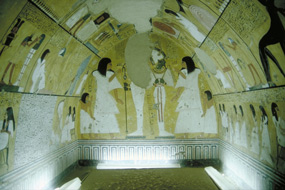Luxor
Tombs
The tombs can be found in the Valley of the Kings and
in the Valley of the Queens. But also tombs of the nobles
and of the workers are of great importance. Some of the
tombs could be closed for restoration without prior notice.
Tombs
in the Valley of the Kings
The canyon, once called the "Gates of the Kings",
is now known as the Valley of the Kings. It is a place
of death, as once the great kings were buried there in
great stone sarcophagi.

Tutankhamun
(no.62)
This tomb made history because it is the single one which
remained nearly intact until it was discovered by Howard
Carter in 1922. Tutankhamun was son-in-law of king Akhenaten.
Unlike its contents the tomb itself is very modest, perhaps
because it was built in great haste as a result of the
unexpected death of the young king. The stone sarcophagus
and the bigger wooden coffin still containing the mummy
are left in the burial chamber.

Tomb
of Thutmosis III
Very impressive are the paintings, which for their concise
graphic style are considered among the most beautiful
in the valley, showing all twelve hours of the night in
ancient Egyptian mythology.
Tombs in the
Valley of the Queens
In this valley 74 tombs of queens, princes and princesses
from the 18th to the 20th dynasty were discovered.

Tomb
of Cha-em Waset (no.44)
He was a son of Ramses III.
The Tombs of the Nobles and the Workers:
Tomb
of Menena (no.69)
Lived in the time of Thutmosis IV. The paintings
in his tomb are very vivid. The decoration depicts scenes
which are among the most elegant in the whole necropolis.

The
Tomb of Sennedjem (no.1)
The tomb consists of only a single arched coffin-chamber,
but its decoration is unique. On one side of the tomb,
Senned Jem, who is accompanied by his wife, is painted
working in the fields of Iaru (paradise), ploughing, sowing
and harvesting grain. On the other side of the tomb Senned
Jem is shown, worshipping gods in the after-life.

